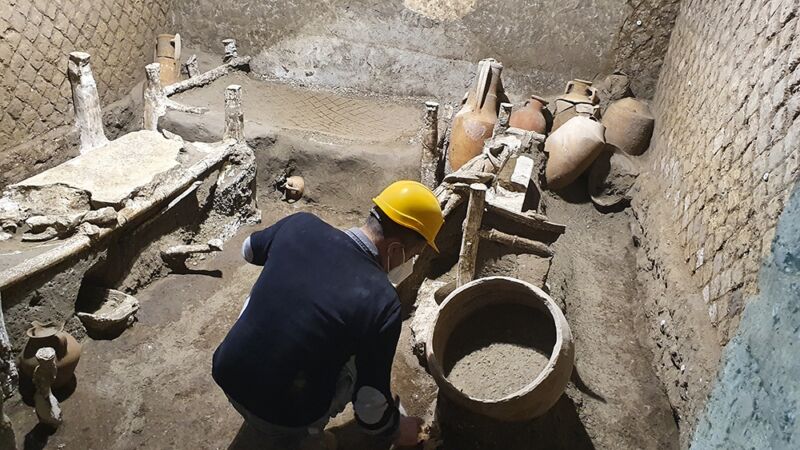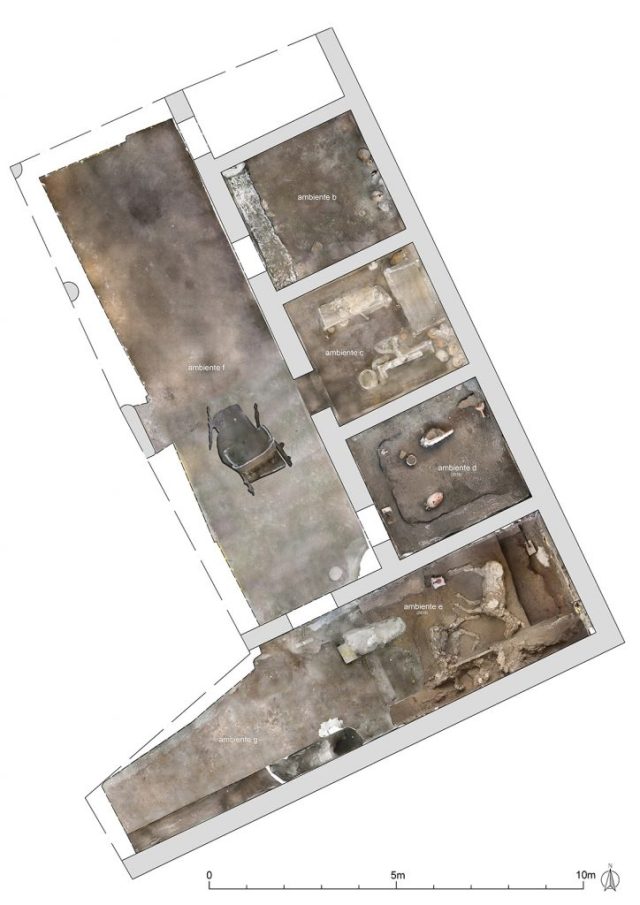
Pompeii Archaeological Park
Just outside the ancient city of Pompeii, archaeologists recently unearthed a small room where at least three enslaved people lived and worked until Mount Vesuvius erupted in 79 CE. The rediscovery of the dreary space near the villa’s stables provides a rare glimpse into the lives of the people at the bottom of the ancient Roman social order.
A small room in a grand villa
When Mount Vesuvius buried the Roman city of Pompeii under meters of ash and pumice, the destruction didn’t stop at the city walls. The Civita Giuliana villa, about 700 meters northwest of the city’s walls, also vanished under dust and rock. Inside the house, a wealthy man and a young laborer—probably enslaved—died together when a pyroclastic flow swept down the volcano’s slopes. Three horses died in the villa’s stables, and archaeologists unearthed their remains in 2018. An ornate ceremonial chariot waited in a nearby portico facing the stables, too late to aid any last-ditch escape attempts.

Pompeii Archaeological Park
Archaeologists have been excavating the villa from beneath layers of volcanic sediment since 2017, and they recently unearthed a small room near the portico and stables, where it appears three people once lived and worked in close, dreary quarters. The three beds of rough wooden planks and rope webbing probably belonged to enslaved people who worked at the villa, according to Pompeii archaeological park director Gabriel Zuchtriegel and his team. No human remains were found in the room, so we have no way of knowing whether its occupants escaped or died elsewhere.
But the room and the few possessions they left behind offer a glimpse “into the precarious reality of people who seldom appear in historical sources that were written almost exclusively by men belonging to the elite,” said Zuchtriegel.
“Cramped and precarious”
“What is most striking is the cramped and precarious nature of this room, which is something between a dormitory and a storage room,” said Zuchtriegel. Eight clay jars, called amphorae, remain stacked in the corners of the room, sharing space with three beds; two were adult-sized, about 1.7 meters long, while the third was 1.4 meters long and may have belonged to a child. That leads archaeologists to speculate that the people who lived and worked in this small, dim space may have been a family, although it’s also possible they were unrelated.
The 16-square-meter room was lit only by a small window high up on one wall, and its walls and floor seem to have been bare. That’s in stark contrast with the wealthy houses of the city, where frescoes and mosaics lend their name to the Villa of the Mysteries, the House of the Orchard, and the House of Venus in the Shell.
Pompeii’s elite, and even its middle classes, lived among beauty and art. Its poorest lived without decoration, or even much light, in cramped quarters that apparently doubled as a workspace and a storeroom. A wooden chest, full of metal and fabric that probably once formed part of the harnesses for the villa’s horses, lay on one bed, and a chariot shaft lay across another. This suggests that the people who lived there performed work related to maintaining chariots and tack and that there wasn’t much distinction between home and workspace.
Personal items were few; tucked under the beds, archaeologists found a ceramic chamber pot, jugs or pitchers, and a few amphorae. The people who lived in this space left nothing behind but blankets (which long since crumbled away, leaving behind cavities in the ash). “The true treasure here is the human experience—in this case, of the most vulnerable members of ancient society—to which this room is a unique testimony,” said Zuchtriegel.
For enslaved people in Pompeii and other cities of the Roman Empire, it was often possible to obtain freedom. A tomb unearthed earlier this year in Pompeii reveals that at least one formerly enslaved man in the city eventually became wealthy and powerful in his own right. But others lived their whole lives in quarters like these.








